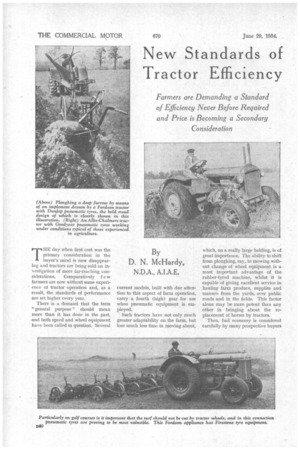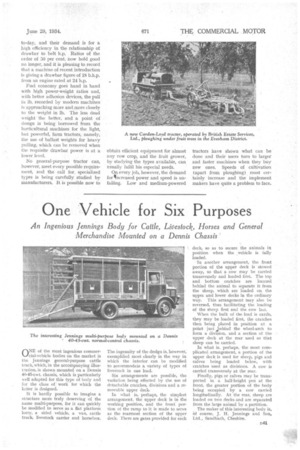New Standards of Tractor Efficiency
Page 94

Page 95

If you've noticed an error in this article please click here to report it so we can fix it.
Farmers are Demanding a Standard of Efficiency Never Before Required and Price is Becoming a Secondary Consideration By D. N. McHardy, N.D.A., A.I.A.E.
THE day when first cost was the primary consideration in the buyer's mind is now disappearing and tractors are being sold on investigation of more far-reaching con siderations. Comparatively f e w farmers are now without some experience of tractor operation and, as a result, the standards of performance are set higher every year.
There is a demand that the term "general purpose" should mean more than it has done in the past, and both speed and wheel equipment have been called in question. Several current models, built with due attention to this aspect of farm operation, carry a fourth (high) gear for use when pneumatic equipment is employed.
Such tractors have not only much greater adaptability on the farm, but lose much less time in moving about, which, on a really large holding, is of great importance. The ability to shift from ploughing, say, to mowing without change of wheel equipment is a most important advantage of the rubber-tyred machine, whilst it is capable of giving excellent service in hauling farm produce, supplies and manure from the yards, over public roads and in the fields. This factor alone may be more potent than any other in bringing about the replacement of horses by tractors.
Then, fuel economy is considered carefully by many prospective buyers
to-day, and their demand is for a high efficiency in the relationship of drawbar to belt h.p. Ratios of the order of 50 per cent, now hold good no longer, and it is pleasing to record that a machine of recent introduction is giving a drawbar figure of 18 b.h.p. from an engine rated at 24 h.p.
Fuel economy goes hand in hand with high power-weight ratios and, with better adhesion' devices, the pull in lb. recorded by modern machines is approaching more and more closely to the weight in lb. The less dead weight the better, and a point of design is being borrowed from the horticultural machines for the light, but powerful, farm tractors, .naniely, the use of ballast weights for heavy pulling, which can be removed when the requisite drawbar power is at a lower level.
No general-purpose tractor can, however, meet every possible requirement, and the call for, specialized types is being carefully studied by manufacturers. It is possible now to obtain efficient equipment for almost any row crop, and the fruit grower, by studying the types available, can usually fulfil his especial needs.
On every job, however, the demand for ncreased power and speed is unfailing. Low and medium-powered tractors have shown what can be done and their users turn to larger and faster machines when they buy new ones, Speeds of cultivation (apart from ploughing) must cer.tainly increase and the implement makers have quite a problem to face.
































































































































































